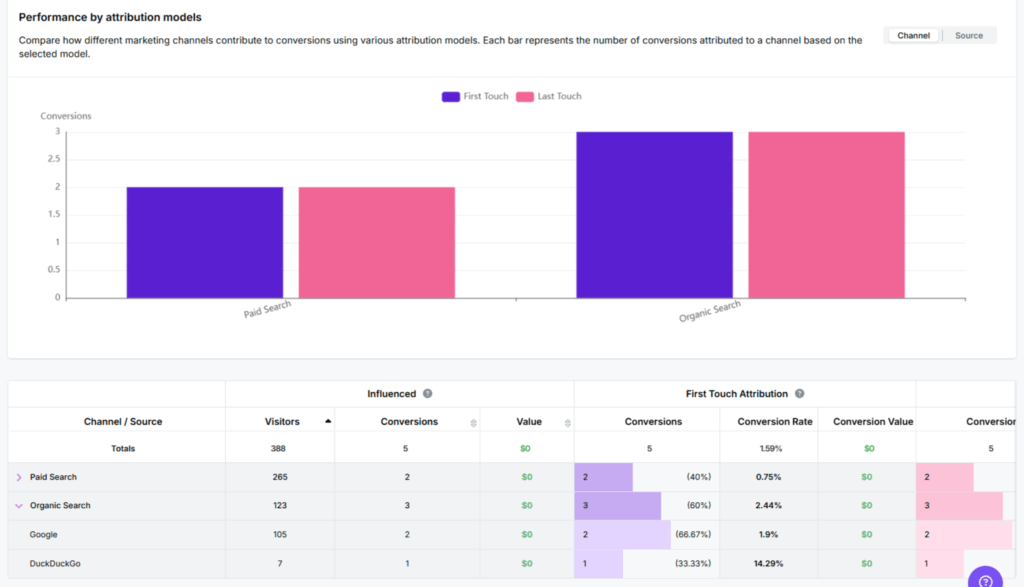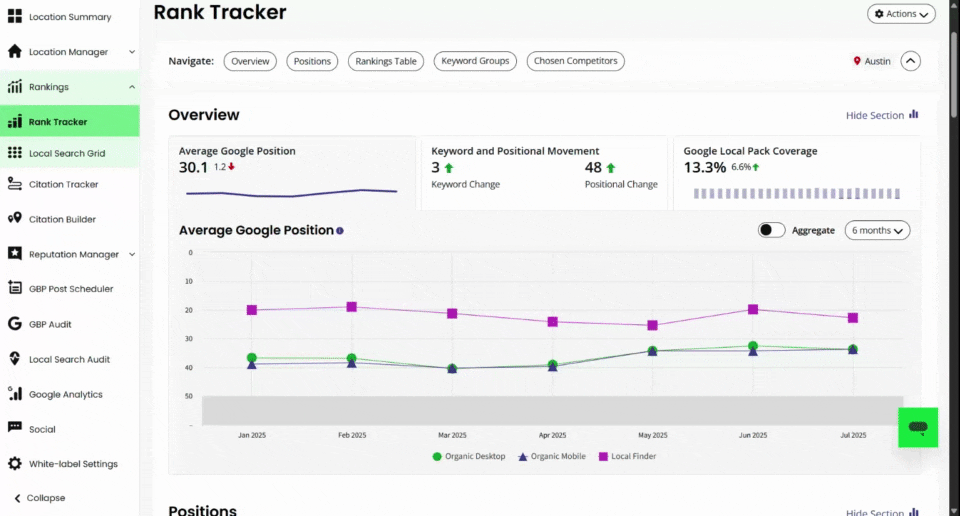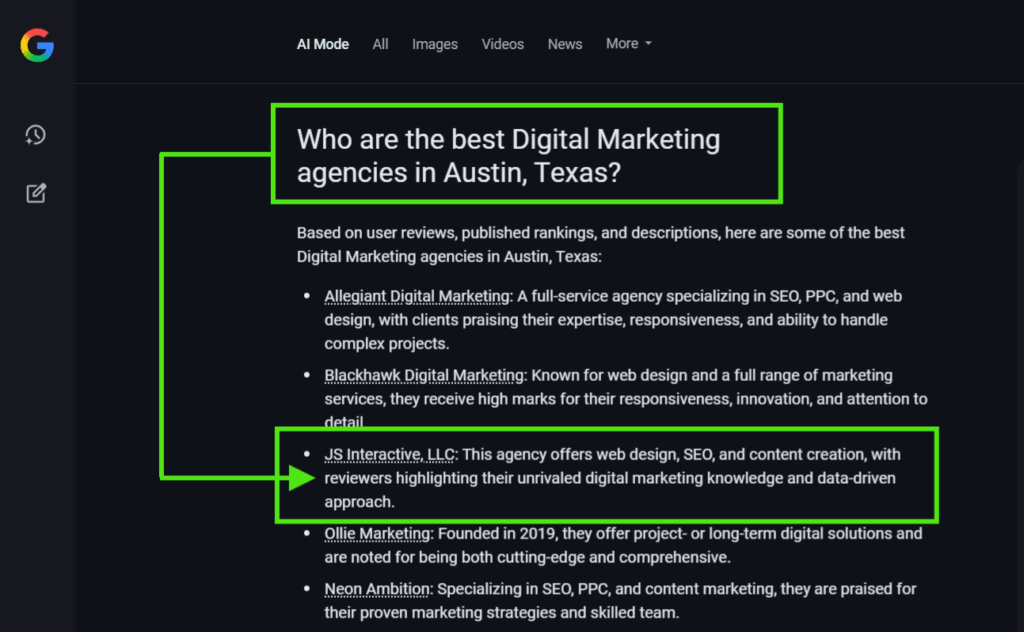10 AI Tools Our Austin Digital Marketing Agency Uses Daily

There was a period when my team and I were constantly chasing recommendations.
Every day, it felt like we were hit with a new ad, email, or social post promoting the next must-try AI tool. Each one promised to simplify our workflow, scale our content, and practically run the operation for us.
We’re a small team, and wearing multiple hats is part of how we operate. Moving fast and performing at a high level isn’t optional. It’s in our DNA.
So yes, we’ve tried a few tools.
A few of them stood out.
Big claims, slick interfaces, highly recommended ‘all-in-one’ solutions. They are supposed to take care of everything—just give it a prompt, review the output, and move forward.
Solving the Bigger Challenge with AI Implementation
Once we got into these AI tools, the fit wasn’t there.
The workflow slowed us down.
The content didn’t sound like us.
The UX was a little janky, and instead of freeing up time, it added more steps we didn’t ask for.
That’s when things clicked.
The challenge is not that we need more features. What we needed was less friction.
Tools that seamlessly integrate into our existing workflows. Tools that support our work without getting in the way.
This experience has shifted our mindset.
We’re not looking for tools to do the work for us, especially not at the expense of our authority, clarity, or reliability. We want tools to work with us.
Our Austin digital marketing agency utilizes AI tools on a daily basis. And we use them with intention.
They help us write faster, analyze smarter, and act on insights more quickly. The difference is, we use them to amplify our thinking, not replace it.
The 10 Tools Behind Our Day-to-Day Marketing Work
We’re not here to “unlock potential” or “harness innovation.”
We’re here to run better campaigns.
At our Austin digital marketing agency, AI tools aren’t a shiny add-on—they’re baked into how we work every day. The tools themselves don’t do the work.
Knowing when and how to use them? That’s where the real value is.
Here’s the stack we rely on, and how each tool fits into our process.
1. Semrush
Semrush is where most of our strategy begins. There is just no other SEO tool out there that is as robust as theirs.
We use it to dig into keyword research, track rankings, monitor competitors, and find content gaps worth filling.
It helps us see what people actually search for and where we can find opportunity, both locally and nationally.
The real value isn’t just in the data. It’s in what we do with it. Semrush provides a starting point, but the strategy emerges from interpreting what matters and what to ignore.
Their new CopilotAI adds another layer by offering personalized recommendations based on actual performance data. It flags technical issues, suggests optimizations, and surfaces opportunities we might otherwise miss.

2. Google Search Console
Search Console is our reality check.
It shows how our content performs in search, not how we hoped it would.
We use it to track clicks, impressions, average position, and the queries bringing users to our site.
It’s handy for technical SEO. Google Search Console utilizes machine learning to identify patterns and surface issues that may not be immediately apparent on your website.
It flags pages that are losing visibility, highlights changes in user behavior, and pinpoints technical problems that may affect performance.
These signals don’t replace strategy, but they inform it.
Search Console tells us what to fix, where to improve, and how to stay aligned with what’s happening in search.
3. UserMaven
UserMaven is a great tool for small businesses that desire to understand what people do, not just what they click.
It’s a privacy-first analytics platform that provides us with clear insight into user behavior without getting bogged down by cookies, pop-ups, or complex setups. It’s also an excellent alternative to Google Analytics’ robust but clunky user experience.

We use it to:
- Automatically track key events and conversion funnels with no coding required.
- Leverage AI to visually map user journeys, spot where people drop off, and receive clear recommendations on where to optimize.
- Segment traffic easily, by channel, device, location, or user behavior, and compare performance across groups.
- Track feature adoption, retention, and drop-off risk all within the same platform.
- Rely on real-time data, fully GDPR/CCPA compliant, and hosted in the EU to ensure data control and privacy.
That means less guessing and more granular clarity, faster.
Those AI insights don’t make decisions for us. They guide us in making smarter ones.
4. ChatGPT
ChatGPT is part writer, part sounding board, part search engine. We don’t treat it like an answer machine. We treat it like a thinking tool.
We use it to brainstorm headlines, refine rough drafts, test how a message might land with different audiences, or gut-check a strategy. It’s especially useful for speeding up internal docs and communication that doesn’t need heavy polish but does need clarity.
The trick is knowing what to ask and how to frame it. A lazy prompt gets lazy output. A sharp, specific prompt gets something worth building on.
Lazy prompt: “Write a blog post about digital marketing.”
Result: Generic advice, no structure, and nothing that speaks to your audience or your brand.
Sharp, specific prompt: “Write an outline for a blog post titled ‘3 Ways Local Businesses in Austin Can Improve Their SEO,’ aimed at small business owners who don’t have a marketing team.”
Result: Targeted, relevant, and something you can actually use.
ChatGPT doesn’t replace writing, strategy, or expertise. However, when we use it effectively, it saves time, reduces back-and-forth, and helps us stay on track.
5. Jasper
Some of our team members utilize Jasper to expedite the initial stages of content creation.
It helps draft blogs, ad copy, emails, and other first-pass content that needs to get out of your head and onto the page. It’s beneficial when you’re staring at a blank screen and a deadline is creeping up.
We don’t use Jasper’s output as-is. We use it to move quickly from idea to draft. That gives us more time to refine the message, sharpen the angle, and make sure it sounds like us.
Like any writing tool, Jasper works best when it has guardrails in place. We lean on saved brand voices, structured templates, and clear prompts to help it generate something worth editing.
6. Grammarly Pro
Grammarly Pro is our final line of defense before content goes live.
It catches grammar slips, awkward phrasing, and tone inconsistencies, especially when we juggle multiple drafts or collaborate across the team.
For internal docs, it keeps things clean. For client-facing work, it helps us maintain the professionalism and quality we expect.
We use the Pro version because the free tool only scratches the surface. Grammarly Pro gives us advanced tone suggestions, full-sentence rewrites, and clarity improvements. These save time and clean up our edits faster. It’s not just spellcheck—it’s a quality check.
Most of our team uses the Chrome extension, which allows us to edit in the moment, whether we’re working inside a Google Doc, an email thread, or a CMS. No copy-pasting, no switching tabs.
It’s a simple tool, but a useful one. The less time we spend cleaning up mistakes, the more time we can spend on strategy.
Just be mindful not to accept ALL recommended edits from Grammarly. You don’t want to lose your personal voice by relying too heavily on its edits.
7. BrightLocal
BrightLocal is how we stay on top of local SEO without getting buried in busywork.
We use it to run audits, track citations, monitor reviews, and keep local listings consistent across the web. For businesses that rely on local visibility—like many of our Austin-focused clients—this consistency adds up fast.
BrightLocal’s AI-driven insights dashboard utilizes machine learning to analyze review sentiment, detect trends, and surface reputation signals, thereby eliminating the need for manual review and enabling a quick understanding and proactive response.

Beyond reviews, BrightLocal’s platform also provides recommendations for resolving listings, citations, and other local SEO issues, enabling us to take action efficiently.
It’s not a flashy tool, but it’s essential. When we keep local business details clean and consistent, users trust the brand, and search engines follow suit. BrightLocal helps us maintain that foundation with smart automation and real-world insights.
8. Local Viking
Local Viking helps us manage and monitor local rankings with precision, for both our agency and our clients.
We use it to schedule posts to Google Business Profiles, track geo-grid rankings, and manage multiple locations without needing to log in and out of accounts. It’s built specifically for agencies handling local SEO at scale.
One of the standout features is the geo-grid rank tracking, which shows how a business ranks across specific points in a physical area, not just by ZIP code.

This is especially valuable in a city like Austin, where visibility can change from one block to the next.
Local Viking also uses AI to suggest optimized posting times, keywords, and categories for Google Business updates. It saves time and eliminates guesswork when we update listings to stay fresh and relevant.
It’s a power tool for local optimization. We rely on it to keep both our brand and our clients visible in the places that matter most.
9. Google Business Profile
We generate a lot of leads through a well-managed and optimized Google Business Profile (GBP).
GBP now includes several AI-powered features that simplify listing management and boost engagement:
- AI-generated business descriptions: GBP can craft a concise business overview tailored to your profile and website content.
- Product Studio AI: Upload a product image and choose a theme to generate lifestyle-style backgrounds—brightening up product listings without the need for photography equipment.
- AI‑enhanced posts: AI can add dynamic backgrounds to your posts on Maps, making updates visually richer.
- Menu transcription: Snap a photo or upload a PDF of your menu, and GBP uses AI to extract item names, descriptions, and prices.
- Smart Q&A (Ask Maps): Google’s Gemini AI can automatically answer common customer questions under the “Ask Maps” feature.
These features improve Business Profiles with AI-powered polish and practical convenience.
They don’t replace human editing or oversight, but save time and help listings look polished and accurate.
We pair GBP with Local Viking and BrightLocal to streamline updates and keep profiles consistently optimized. AI helps us and our clients update business descriptions, refresh product images, and stay efficient without slowing down.
10. AI Overviews
AI Overviews is one of Google’s most well-known AI features, and we’re paying close attention to it.
Google uses generative AI to create concise summaries at the top of search results, pulling from multiple sources and skipping traditional blue links. For businesses, it raises new questions:
- Will users still click through to websites?
- How do we get cited in these summaries?
- What content gets featured?
We continue to experiment with it, but we haven’t reshaped our strategy around it. The rollout is still evolving, and we’ve seen summaries that feel inconsistent or off base. Right now, we’re focused on:
- Understanding the types of content that appear
- Learning how citations work
- Identifying what signals might influence inclusion
We’re not building our strategy around it, but we’re watching it closely.
Google’s AI Mode
Google’s AI Mode is part of the new search experience, which utilizes generative AI to answer questions quickly and surface local business results directly in search.
It’s still rolling out, but the impact is already showing.
We recently spotted our agency featured in one of those results, listed as a ‘top digital marketing agency in Austin’.

It’s a small but important sign that AI is already shaping visibility in ways most people aren’t paying attention to.
Tools Only Matter When the Strategy Is Sharp
We rely on these tools every day, but we choose them carefully.
AI helps us move faster, make clearer decisions, and focus our time where it matters. The real advantage comes from knowing how and when to use them … intentionally.
We keep every tool in our stack because it supports strategy, not because it replaces it. That’s what keeps our work sharp, relevant, and focused on results.
Curious how this looks in practice? Contact us today and let’s discuss how we can apply it to your business.